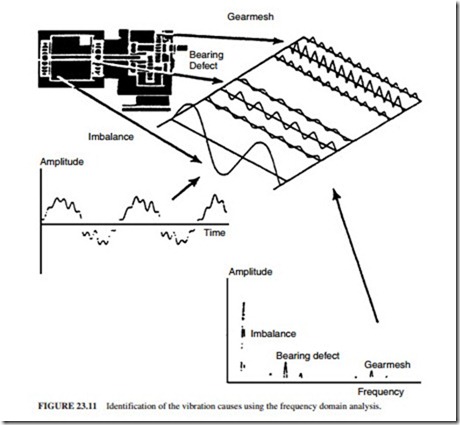MACHINERY EXAMPLE
Figure 23.11 illustrates the usefulness of the frequency domain analysis for a vibrating machine. The internal sources of vibration are rotor imbalance, a ball bearing defect, and reduction gear meshing.
VIBRATION ANALYSIS
The first step in vibration analysis is the understanding of the machinery (expensive diagnostic equipment is useless if the machine is not well understood). A study of the machine dynamics should precede the taking of vibration readings.
Vibration Causes
A wide variety of faults that result from wear, damage, or poor installation may lead to vibration in machinery. Vibration may also be caused by an inherent and unavoidable mechanical feature such as the reaction of turbine blades passing an opening.
However, serious vibration problems occur when one of the forcing frequencies approaches one of the natural frequencies of vibration. This is known as resonance. It amplifies the effect of the forcing frequency.
Forcing-Frequency Causes
The first step in performing vibration analyses is to investigate the forcing frequencies which result from any of the following causes.
Unbalance
Unbalance is characterized by sinusoidal vibration at the machine’s running speed. It occurs when the center of mass of a component does not coincide with its center of rotation.
The majority of vibration problems are caused by unbalance. The features of vibration from unbalance are that
1. It is a single-frequency vibration which has a constant amplitude in all radial directions.
2. It increases with speed and does not contain harmonics (higher-frequency vibrations).
Misalignment
Vibration is generated when there is a misalignment between shafts of connected machines. It can be mistaken for unbalance. Its distinguishing feature is that its princi- pal frequency is at 1, 2, and 3 times the shaft rotational speed. Also, it contains a large axial component. Special cases of misalignment are improperly seated bearings and bent shafts.
Mechanical Looseness
Mechanical looseness vibrations occur at 1 X rotational speed. However, it always contains higher harmonics. Mechanical looseness can often be located by taking several velocity readings at different points on the machine. The measured vibrations will be the highest in the vicinity and direction of looseness.
Bearing Defects
The most common cause of failures in small machinery is due to rolling-element bearings. The vibration is usually caused by a defect in the inner race, outer race, or rolling elements. The vibrations are characterized by high frequency and low energy.
Formulas are used to determine the exact frequency generated by a fault in a race if the dimensions of the inner and outer races and the rolling elements are known.
Gear Defects
High-frequency vibrations are also generated by gear meshing. They are usually low- energy signals that are easy to recognize but difficult to interpret.
The vibration frequency is equal to the rotational speed of the gear times the number of teeth. The vibration amplitude varies with the load.
Oil Whirl
Oil whirl in bearings is caused by instability of the rotor which is supported by the liquid film. Changes in oil viscosity, pressure, or external preloads produce conditions that pre- vent the film from supporting the shaft, and bearing wipe occurs.
Blade or Vane Problems
Blade or vane passing generates single-frequency vibration or a large number of harmonics close to the blade passing frequency. The amplitude varies considerably with load. A cracked or missing blade usually increases the number of harmonics without changing the fundamental frequency.
Electric Motor Defects
Motor vibrations are caused by mechanical or electrical defects. The frequency generated by a broken rotor bar (mechanical defect) is distinguished from an electrical defect by the amount of motor slip. A simple technique is used to differentiate mechanical from electrical problems in motors. If the vibration remains unchanged when the motor is turned off, the deficiency is mechanical in nature.
Uneven Loading
Vibrations are generated by uneven loading (such as a belt drive on an eccentric pulley). The vibration is generated at running speed. It could be mistaken for unbalance. The vibration is distinguished by being unidirectional and usually varies with the load.
Driveshaft Torsion
Torsional vibration is becoming a problem with the advent of variable-frequency drives which may contain many electric harmonics. Torsional vibrations do not generate an externally measurable effect on the machine. They cannot be detected by conventional vibration sensors.
Related posts:
Incoming search terms:
- examples of vibrating equipment
- https://yandex ru/clck/jsredir?from=yandex ru;search;web;;&text=&etext=1820 DgE0p046xQvxayetdji7IAZgGsmggEutnSyu6gJtdpSzl0-3XuG9zQhuPfIycSfXvSuVvK6QR4HPgfbhvFchuQ 58980b2cd1b76d483a47016197c6760825c33d73&uuid=&state=_BLhILn4SxNIvvL0W45KSic
- https://yandex ru/clck/jsredir?from=yandex ru;search;web;;&text=&etext=1828 5Ti2KCJY9NnYkHAWwh9x8uiJQBEqevLUu7zkCk7oDpor6k4W0debqriP_oEF8-S47yP1hyVqiaVqD7RPX3EnlA 9c7ea6928e1582ecf6194f34186d71dad23eb652&uuid=&state=_BLhILn4SxNIvvL0W45KSic
- https://yandex ru/clck/jsredir?from=yandex ru;search;web;;&text=&etext=1834 fxQteFSB8JYPASJo3Rw0Vt6WwW2oPi4kNh9_dAzMkAV0eVD9bv6pH8UwaF2mw3IvqLiLohqMwtUUSf-5T0EDbA 1ddb539b2f1116b72aac16be6d8cc18e5d1d1dcc&uuid=&state=_BLhILn4SxNIvvL0W45KSic
- unavoidable machinery vibration
- vibration analysis examples
